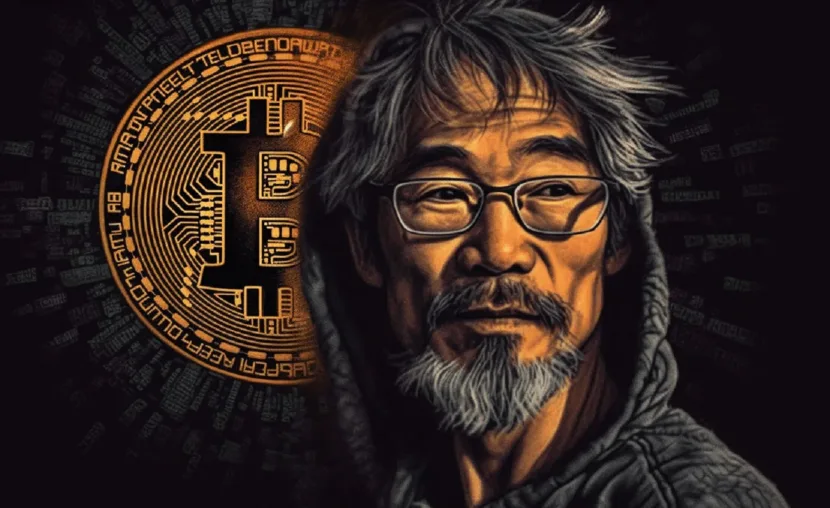Who Invented Bitcoin? Unveiling the Enigma Behind the Revolutionary Cryptocurrency
Bitcoin’s mystery roots are like digital footprints—always dead ends and bogus identities. Who invented Bitcoin, and why is it secret? Someone who created a trillion-dollar currency would want to succeed. However, “Satoshi Nakamoto” has never appeared, sparking numerous conspiracy theories—a brilliant individual designed Bitcoin to free money from governments and banks. Cypherpunk collective Nakamoto may aim to make encryption the core of internet business. Bitcoin’s groundbreaking goal to decentralize banking via technology makes its beginnings obscure. Since Bitcoin decentralizes banks, this makes sense. As an alternative to fiat currencies, Bitcoin was created in 2008. The global financial crisis inspired its establishment. However, its inventor has remained unknown for almost a decade, deepening the mystery.
The identity of Satoshi Nakamoto is unknown despite much investigation and speculation. Some say Nakamoto was a group, others an individual—Bitcoin’s origins, which have enthralled the cryptocurrency community and beyond, boost its appeal.
BRIEF BITCOIN HISTORY
In late 2008, “Satoshi Nakamoto” published “Bitcoin: A Peer-to-Peer Electronic Cash System” online. It proposed a decentralized digital currency using encryption to create and transfer money. Bitcoin began mysteriously about this time. Bitcoin may enable peer-to-peer finance.
The study was initially ignored despite its remarkable findings. After Bitcoin code was released as open-source in 2009, the first Bitcoins were “mined.” However, Bitcoin debuted in 2009.
Early adopters and miners developed a Bitcoin community after its success. The community revolves around cryptocurrency. Bitcoin peaked in 2010 at eight cents. Important periodicals covered Bitcoin’s rise in value throughout the next few years. Thus, Bitcoin became famous.
Satoshi Nakamoto never recognized his role in Bitcoin’s invention and left the community in 2011. The mysterious Bitcoin designer’s identity is still unknown; thus, there is infinite speculation. Cryptocurrency was introduced in 2008, but its originator is unknown. The most widely accepted theory is that Satoshi Nakamoto, an anonymous programmer or group, designed Bitcoin.
Nakamoto announced Bitcoin on a cryptography mailing list in 2008. Soon later, Nakamoto released Bitcoin’s software and blockchain. Nakamoto improved Bitcoin with engineers before disappearing in 2011. He vanished. No one knows Nakamoto’s name despite several attempts.
Several theories say a government agency or big company who invented Bitcoin. This speculation has supporters. However, most crypto experts believe Nakamoto loved cryptography. Hal Finney invented cryptography before Bitcoin. He interacted with Bitcoin developer Satoshi Nakamoto and used it early. Despite suspicions, Finney denies being Nakamoto.
Computer scientist Nick Szabo, known for his work on digital contracts and currency, was also thought to have conceived Bitcoin. Digital money and electronic contracts are Szabo’s expertise. Szabo invented “bit gold” before Bitcoin with Nakamoto-like ideas. To Szabo, Bitcoin was invented. Szabo denied being Satoshi.
Other possibilities include cryptographer Lan Grigg, computer scientists Michael Clear and Vili Lehdonvirta, and the Dublin-based Crypto Mano Group. No one has shown they are Nakamoto.
Bitcoin’s origin is uncertain. Even though Satoshi Nakamoto may never be identified, his product changed technology and money. Bitcoin whitepaper proposed a decentralized digital currency that would alter money. The vision was about Bitcoin. Despite being established for nearly ten years, Bitcoin encourages blockchain and cryptocurrency innovation.
Bitcoin shows the possibilities of decentralized technologies and digital innovation. It started a global money and trust conversation beyond banks. It sparked this discussion. This led to blockchain applications across various industries. Bitcoin is still traveling, but it will remain the first cryptocurrency since Bitcoin was the first cryptocurrency.
BITCOIN’S CREATOR AND MARKET IMPACT EXPLAINED
Bitcoin’s founder is unknown. Anonymous Satoshi Nakamoto designed Bitcoin in 2008—by an unknown person or organization. Although various people have been suggested as Nakamoto, the truth is unknown. Nakamoto’s identity was questioned after 2008 cryptography mailing list communications about Bitcoin’s early code were revealed. In 2020, these messages appeared. Satoshi Nakamoto signed the letters, demonstrating his knowledge of economics and cryptography.
Due to the professional skill demonstrated in early Bitcoin writings, many experts assume Nakamoto was a group. Because these publications were skilled, Nakamoto employed British spelling norms and flawless English in those messages, claiming he was a single, highly educated individual who did not speak English due to Nakamoto’s British spelling.
Nakamoto’s invention transformed the world regardless of his identity. The first decentralized digital money by Nakamoto transformed finance and technology. He offered an alternative to government-issued currencies. Because Bitcoin is so popular, thousands have developed cryptocurrencies.
The Nakamoto mystery has made Bitcoin popular and legendary. Journalists and amateur detectives have hunted the Bitcoin mastermind for almost a decade. They’ve sought him. Reading forum threads and assessing Nakamoto’s writing has yielded clues. Nakamoto seemed to have hidden their track. Satoshi Nakamoto is a ghost with no known identity or location. Nakamoto who invented Bitcoin regardless of their identity.
Bitcoin’s conventional monetary viability is also questioned. These challenges originate from Bitcoin’s volatility and scalability. The Lightning Network and other layer-two solutions address these difficulties, but Bitcoin’s mainstream acceptability is still being established.
Overall, Satoshi Nakamoto’s creation of Bitcoin revolutionized the market. It changed finance and promoted technological and financial innovation. Bitcoin still intrigues millions despite its issues. Their trademarks are decentralization and financial sovereignty.
HOW RICH IS SATOSHI NAKAMOTO?
Nobody knows Satoshi Nakamoto’s true identity, making wealth estimates difficult. According to our study, Nakamoto mined over one million bitcoins before disappearing. Bitcoin topped $20,000 in 2017, making these coins worth over $19 billion. Nakamoto has never cashed out. Thus, we don’t know their lifetime cryptocurrency holdings.
Many believe Nakamoto’s bitcoins remain unchanged. If the public embraces Bitcoin, Nakamoto’s holdings may rise quickly. If Bitcoin’s value keeps declining and Nakamoto never sells any, they may be worthless. Because Nakamoto never sold it. Whatever the case, Nakamoto’s involvement in blockchain technology and Bitcoin’s creation enhance its mystique. The Bitcoin network’s open-source technology was established in 2009. They then worked with other developers until mid-2010, when they disappeared online. Nakamoto developed Bitcoin in 2008 with a white paper on a “peer-to-peer electronic cash system.” They worked with other developers before disappearing.
Many have sought to identify Nakamoto since then. Computer scientists, cryptographers, and Elon Musk are possibilities. Each fresh piece of information deepens the enigma. Nakamoto made various steps to remain anonymous and cover their trails.
Nakamoto’s identity and riches are unknown; therefore, speculation abounds. Their breakthrough technology could upset the banking system and change how money is used in the future. They left this true legacy. Satoshi Nakamoto’s identity may never be known, but their amazing vision continues to inspire and push human limits.
Even though Satoshi Nakamoto is nameless and Bitcoin’s value is speculative, his holdings may be enormous. Nakamoto may never access or disclose their Bitcoins; therefore, their value is unknown. Bitcoin creator Nakamoto is anonymous.
THE MYSTERIOUS SATOSHI NAKAMOTO
Bitcoin founder Satoshi Nakamoto was a mystery. This person or people are unknown. Nakamoto wrote a 2008 Bitcoin paper. After the investigation, Nakamoto worked on the open-source code before leaving, following the first paper.
Speculation surrounds Nakamoto’s identity. Some think it was a team effort. Japanese mathematician Shinichi Mochizuki, Irish cryptography student Michael Clear, and Tesla CEO Elon Musk are candidates. Three qualifying candidates are listed. These possibilities remain unproven.
Nakamoto is unknown. Their unique decentralized digital money concept changes the world. Nakamoto retrieved Bitcoin’s genesis block. The event occurred on January 3, 2009. The first block contained the 2008 bank bailout message. The enigmatic letter helped Nakamoto create a monetary system without a central bank.
Despite utilizing the pseudonym, Nakamoto was active with Bitcoin early on. He moderated message boards and forum debates. They wrote friendly emails and blogs. Nakamoto graciously answered miners’ and developers’ questions. Nakamoto stopped communicating around 2010 and hasn’t been seen since. Nakamoto’s disappearance has increased their intrigue. The Bitcoin creator’s identity is unknown, yet their technology changed the world. Blockchain could alter finance. Bitcoin’s distributed blockchain network continues Nakamoto’s “peer-to-peer electronic cash system” after his death.
The Satoshi Nakamoto mystery grows despite ongoing searches. Bitcoin’s origin remains mysterious. Nakamoto may emerge from the shadows to claim their legacy. Satoshi Nakamoto’s mythology has intrigued and surprised those who solve digital age mysteries.
THE DISCOVERY CASTS DOUBT ON SATOSHI NAKAMOTO’S HUMANITY.
Satoshi Nakamoto’s identity remains unclear after years. Although Bitcoin’s founder hasn’t been seen since 2011, the first cryptocurrency’s creator is still debated. Bitcoin’s founder is unknown.
Satoshi Nakamoto may have created Bitcoin alone to create decentralized digital money. According to this idea, Satoshi Nakamoto built Bitcoin alone. Yet, many assume Satoshi was a libertarian or cryptographer group. Hal Finney and Nick Szabo have been suggested as Satoshi, but none have succeeded.
Our best guess is that Satoshi Nakamoto was a group alias. For one individual to write and create the Bitcoin white paper and software, they look too professional. Satoshi wrote on forums at various times of day and night, giving the impression of a multi-timezone community.
Hiding their identities affords Satoshi, an individual or group, several benefits. Bitcoin is decentralized and open-source because it has no leader. No one has it. Rising Bitcoin value and popularity make more people desire Satoshi to reveal and guide themselves. Over time, these demands have been made. Due to their anonymity, bitcoin ownership and intellectual property rights may present issues for Satoshi.
Satoshi Nakamoto’s identity is disputed. This continues until further notice—Satoshi who invented Bitcoin, a revolutionary technology. Social and financial changes continue with this tech. Satoshi’s identity may never be revealed, but their invention shows human intelligence, inventiveness, and freedom. Bitcoin belongs to us.
In conclusion, Satoshi Nakamoto’s validity is unknown, causing mystery and curiosity in the Bitcoin community and beyond. Skeptics doubt Nakamoto’s identity and a more complicated conspiracy, including pseudonyms, collaboration, or concealment. Bitcoin supporters say a forward-thinking architect designed Bitcoin, while skeptics disbelieve Nakamoto. Bitcoin transformed finance and IT. Decentralized digital currency and blockchain and cryptography studies have been shaped by it. This applies regardless of Nakamoto’s identity.
ENDING COMMENTS
This means we may never know who invented Bitcoin or their first goals. The legendary Satoshi Nakamoto adds intrigue and appeal to this unusual cryptocurrency’s origins. Bitcoin, one of the most disruptive financial innovations, may have been created by a mysterious organization. However, some believe Bitcoin was founded by one company. It invented a new industry and business model. Even though its creator wants to remain anonymous, Bitcoin changes how we think about money, technology, and financial independence. This story will continue.
The enigmatic beginnings of Bitcoin are as intriguing as the revolutionary digital currency—bitcoin money. Bitcoin has risen from an unknown experiment to a global phenomenon with a trillion-dollar market cap. Bitcoin’s market cap hits $1 trillion. Bitcoin was invented almost a decade ago, but its origin is unknown. Bitcoin was invented anonymously. People assume others and not Satoshi Nakamoto, who invented Bitcoin. These riddles can clarify the financial revolution’s ambition as Bitcoin gains popularity. This understanding can be gained by solving these riddles. Bitcoin’s creators and objective: Look behind the scenes to understand the mysterious Bitcoin craze’s founder. In certain circumstances, the truth is stranger than fiction.


